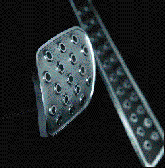CarTest! Expert car reviews and advice | home
CarTest! Expert car reviews and advice | CarTest Contents | New Car Reviews | Used Car Reviews | What is your car worth? | Automotive NewsBriefs | Award-Winning Models | Find the Best Vehicle | Automotive Advice | Save on Gas | Driving Tips & Maintenance Advice | Safety Research & Insurance Tips | Tire Advice | Road Trips | Auto Racing | Classics & Collectibles | Newsletter | About Us | SEARCH CarTest!

©CarTest.ca. All rights reserved.
Avoiding the pain of driving
Why you get tired -- and can hurt -- on long drives
 It may seem harmless enough, just sitting in or driving a moving vehicle. However, anyone who spends a lot of time sitting in a vehicle without changing position or getting out to stretch every hour or two may experience aches, pains and stiffness. This is especially true for people whose work involves driving for long periods of time on a regular basis.
It may seem harmless enough, just sitting in or driving a moving vehicle. However, anyone who spends a lot of time sitting in a vehicle without changing position or getting out to stretch every hour or two may experience aches, pains and stiffness. This is especially true for people whose work involves driving for long periods of time on a regular basis.Common injuries and health effects associated with prolonged driving include:
The root causes of most injuries from driving can be attributed to sitting for long periods of time and whole-body vibration.
The sitting position flattens out the small of your back, increasing the pressure on the discs in your spine. When you are sitting, your discs may not be able to handle the vibrations from your vehicle. Also, the ligaments in your back that help to hold your spine together as you move can stretch and slacken when you sit for a long time. And they can stay that way for a while, even after you stand. These stresses on your discs and ligaments can increase your risk for back injury.
Whole-body vibration triggers bursts of back muscle activity. This unconscious activity causes neck and back muscles to get tired more quickly, and reduces the support these muscles can give to the spine. Even if the muscles are not working very hard, without rest they will become fatigued which increases the risk of back injury. Exposure to whole body vibration for a long time and the increased disc pressure from sitting can injure your back.
Injuries or discomfort are also caused by:
People who drive for a living or spend long periods of time sitting in a vehicle are at increased risk for injury. Occupations include truck drivers, ambulance drivers, taxi and bus drivers, delivery people, heavy equipment operators, farmers, forklift operators and anyone who drives for long periods of time on a regular basis.
Tips to help avoid the potential health hazards of driving
Adjust your seat and steering wheel to ensure you:
Tilt the seat cushion until your thighs are supported along the full length of the cushion without pressure at the back of your knees.
Tilt your seat a notch or two back and forth every 20-30 minutes to change the direction of vibration on your body, if this can be done safely.
Keep your suspension system in good working order and, if necessary, add extra padding over your seat to absorb vibration.
Use a lumbar support to help you fit the back rest to your back - a rolled up towel in the right place will work just fine.
Use good posture - try not to slouch.
Stop and take regular rest/stretch breaks for several minutes every hour or two.
More information
Driving and ergonomics fact sheet, OSH Answers from CCOHS http://www.ccohs.ca/oshanswers/ergonomics/driving.html
Ergonomics And Driving, from Occupational Health Clinics for Ontario Workers, Inc. (OHWCO) http://www.ohcow.on.ca/resources/handbooks/ergonomics_driving/Ergonomics_And_Driving.pdf
The International Organization of Standardization (ISO) has published recommended limits for human exposure to whole-body vibration. http://www.iso.org/iso/search.htm?qt=human+exposure+to+whole-body+vibration&sort=rel&type=simple&published=on
CarTest.ca. Posted Nov. 19, 2009.
Search CarTest!

Custom Search